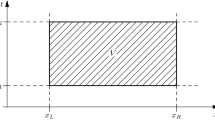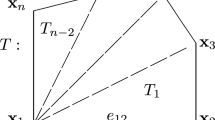Abstract
In this paper, an improved superconvergence analysis is presented for both the Crouzeix-Raviart element and the Morley element. The main idea of the analysis is to employ a discrete Helmholtz decomposition of the difference between the canonical interpolation and the finite element solution for the first-order mixed Raviart–Thomas element and the mixed Hellan–Herrmann–Johnson element, respectively. This in particular allows for proving a full one-order superconvergence result for these two mixed finite elements. Finally, a full one-order superconvergence result of both the Crouzeix-Raviart element and the Morley element follows from their special relations with the first-order mixed Raviart–Thomas element and the mixed Hellan–Herrmann–Johnson element respectively. Those superconvergence results are also extended to mildly structured meshes.
Similar content being viewed by others
References
Arnold, DN, Brezzi, F: Mixed and nonconforming finite element methods: implementation, postprocessing and error estimates. ESAIM Math. Model. Numer. Anal. 19(1), 7–32 (1985)
Douglas, N.A., Falk, R.S., Winther, R.: Differential complexes and stability of finite element methods I. The de Rham Complex. In: Compatible Spatial Discretizations, pp 23–46. Springer, New York (2006)
Bank, R.E., Xu, J.: Asymptotically exact a posteriori error estimators, part I: Grids with superconvergence. SIAM J. Numer. Anal. 41(6), 2294–2312 (2003)
Bramble, J.H., Pasciak, J.E., Schatz, A.H.: The construction of preconditioners for elliptic problems by substructuring I. Math. Comput. 47(175), 103–134 (1986)
Brandts, J.H.: Superconvergence and a posteriori error estimation for triangular mixed finite elements. Numer. Math. 68(3), 311–324 (1994)
Brandts, J.H.: Superconvergence for triangular order k = 1 Raviart-Thomas mixed finite elements and for triangular standard quadratic finite element methods. Appl. Numer. Mathe. 34(1), 39–58 (2000)
Brenner, S., Scott, R: The Mathematical Theory of Finite Element Methods, 3rd ed. Springer, New York (2008)
Brezzi, F.: On the existence, uniqueness and approximation of saddle-point problems arising from Lagrangian multipliers. Revue française d’automatique, informatique, recherche opérationnelle. Analyse numérique
Brezzi, F., Douglas, J., Marini, L.D.: Two families of mixed finite elements for second order elliptic problems. Numer. Math. 47(2), 217–235 (1985)
Brezzi, F., Raviart, P.-A.: Mixed finite element methods for 4th order elliptic equations. Topics in numerical analysis, III (Proc. Roy Irish Acad Conf) (1976)
Chen, C., Huang, Y.: High accuracy theory of finite element methods (1995)
Chen, H., Bo, L.: Superconvergence analysis and error expansion for the Wilson nonconforming finite element. Numer. Math. 69(2), 125–140 (2013)
Crouzeix, M., Raviart, P.-A.: Conforming and nonconforming finite element methods for solving the stationary Stokes equations. Revue française d’automatique informatique recherche opérationnelle, Mathé,matique 7(R3), 33–75 (1973)
Douglas, J., Roberts, J.E.: Global estimates for mixed methods for second order elliptic problems. Math. Comput. 44(169), 39–52 (1985)
Douglas, J., Wang, J.: Superconvergence of mixed finite element methods on rectangular domains. Calcolo 26(2-4), 121–133 (1989)
Durán, R.: Superconvergence for rectangular mixed finite elements. Numer. Math. 58(1), 287–298 (1990)
Hu, J., Huang, Y., Lin, Q.: Lower bounds for eigenvalues of elliptic operators: By nonconforming finite element methods. J. Sci. Comput. 61, 196–221 (2014)
Hu, J., Ma, R.: The Enriched Crouzeix-Raviart elements are equivalent to the Raviart-Thomas elements. J. Sci. Comput. 63(2), 410–425 (2015)
Hu, J., Ma, R.: Superconvergence of both the Crouzeix-Raviart and Morley elements. Numer. Math. 132(3), 491–509 (2016)
Jun, H., Shi, Z.-C.: Constrained quadrilateral nonconforming rotated Q1 element. J. Comput. Math. 23(6), 561–586 (2005)
Yunqing, H., Xu, J.: Superconvergence of quadratic finite elements on mildly structured grids. Math. Comput. 77(263), 1253–1268 (1986)
Claes, J.: On the convergence of a mixed finite-element method for plate bending problems. Numer. Math. 21(1), 43–62 (1973)
Krendl, W., Rafetseder, K., Zulehner, W.: A decomposition result for biharmonic problems and the Hellan-Herrmann-Johnson method. Electron. Trans. Numer. Anal. 45, 257–282 (2016)
Li, Y.: Global superconvergence of the lowest order mixed finite element on mildly structured meshes. SIAM J. Numer. Anal. 56(2), 792–815 (2018)
Lin, Q., Tobiska, L., Zhou, A.: Superconvergence and extrapolation of non-conforming low order finite elements applied to the Poisson equation. IMA Journal of Numerical Analysis, 25(1) (2005)
Lions, J.L., Magenes, E.: Non-homogeneous boundary value problems and applications. Lithos 118(3–4), 349–364 (1972)
Mao, S., Shi, Z.: High accuracy analysis of two nonconforming plate elements. Numer. Math. 111(3), 407–443 (2009)
Marini, L.D.: An inexpensive method for the evaluation of the solution of the lowest order Raviart-Thomas mixed method. SIAM J. Numer. Anal. 22 (3), 493–496 (1985)
Ming, P., Shi, Z., Yun, X.: Superconvergence studies of quadrilateral nonconforming rotated Q1 elements. Int. J. Numer. Anal. Model. 3(3), 322–332 (2006)
Morley, L.S.D.: The triangular equilibrium element in the solution of plate bending problems. Aeronaut. Quarterly 19(2), 149–169 (1968)
Raviart, P.-A., Thomas, J.-M.: A mixed finite element method for second order elliptic problems, pp 292–315. Springer, Berlin (1977)
Funding
The authors were supported by NSFC projects 11625101.
Author information
Authors and Affiliations
Corresponding author
Additional information
Communicated by: Paul Houston
Publisher’s note
Springer Nature remains neutral with regard to jurisdictional claims in published maps and institutional affiliations.
Rights and permissions
About this article
Cite this article
Hu, J., Ma, L. & Ma, R. Optimal superconvergence analysis for the Crouzeix-Raviart and the Morley elements. Adv Comput Math 47, 52 (2021). https://doi.org/10.1007/s10444-021-09874-7
Received:
Accepted:
Published:
DOI: https://doi.org/10.1007/s10444-021-09874-7
Keywords
- Superconvergence
- Crouzeix-Raviart element
- Morley element
- Raviart–Thomas element
- Hellan–Herrmann–Johnson element




